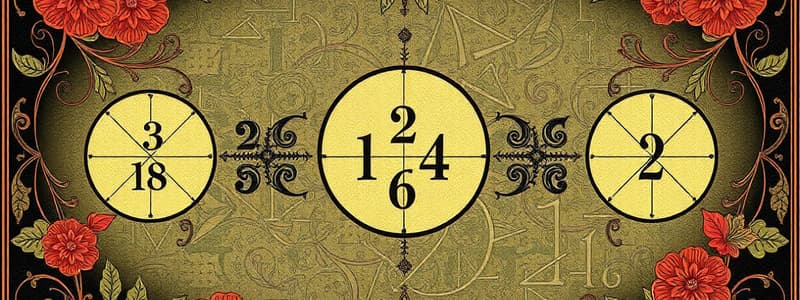Podcast
Questions and Answers
What type of fraction is $\frac{15}{4}$?
What type of fraction is $\frac{15}{4}$?
- Mixed fraction
- Equivalent fraction
- Proper fraction
- Improper fraction (correct)
Which of the following fractions is equivalent to $\frac{1}{2}$?
Which of the following fractions is equivalent to $\frac{1}{2}$?
- $\frac{3}{8}$
- $\frac{4}{6}$
- $\frac{2}{6}$
- $\frac{5}{10}$ (correct)
What is the sum of $\frac{3}{8} + \frac{4}{8}$?
What is the sum of $\frac{3}{8} + \frac{4}{8}$?
- $\frac{1}{8}$
- $\frac{12}{64}$
- $\frac{7}{8}$ (correct)
- $\frac{7}{16}$
What is $\frac{5}{6} - \frac{4}{7}$?
What is $\frac{5}{6} - \frac{4}{7}$?
If a garden is half planted with okra and $\frac{3}{8}$ is planted with green vegetables, what fraction of the garden is planted?
If a garden is half planted with okra and $\frac{3}{8}$ is planted with green vegetables, what fraction of the garden is planted?
Which fraction is greater, $\frac{7}{8}$ or $\frac{8}{9}$?
Which fraction is greater, $\frac{7}{8}$ or $\frac{8}{9}$?
What is the result of $\frac{2}{5} \times \frac{3}{4}$?
What is the result of $\frac{2}{5} \times \frac{3}{4}$?
If Amina took $\frac{2}{5}$ of a piece of cloth and Anna took $\frac{1}{10}$ of the same cloth, what fraction was taken in total?
If Amina took $\frac{2}{5}$ of a piece of cloth and Anna took $\frac{1}{10}$ of the same cloth, what fraction was taken in total?
A teacher spent $\frac{1}{3}$ of her salary on school fees and $\frac{2}{5}$ on domestic expenses. What fraction of her salary did she spend in total? Express the answer in simplest form.
A teacher spent $\frac{1}{3}$ of her salary on school fees and $\frac{2}{5}$ on domestic expenses. What fraction of her salary did she spend in total? Express the answer in simplest form.
A certain cooperative union mandates that villagers sell $\frac{3}{9}$ of their cotton to them. They mandate that the villagers sell the cooperative union another $\frac{4}{9}$ of their cotton. However, some villagers, aiming to subvert the cooperative's control, secretly sell $\frac{1}{18}$ of their cotton to private buyers, defying the mandate. What fraction of their cotton does the cooperative effectively control?
A certain cooperative union mandates that villagers sell $\frac{3}{9}$ of their cotton to them. They mandate that the villagers sell the cooperative union another $\frac{4}{9}$ of their cotton. However, some villagers, aiming to subvert the cooperative's control, secretly sell $\frac{1}{18}$ of their cotton to private buyers, defying the mandate. What fraction of their cotton does the cooperative effectively control?
Flashcards
What is a proper fraction?
What is a proper fraction?
Fractions where the numerator is smaller than the denominator.
What is an improper fraction?
What is an improper fraction?
Fractions where the numerator is bigger than or equal to the denominator.
What is a mixed fraction?
What is a mixed fraction?
A number consisting of a whole number and a proper fraction.
What are equivalent fractions?
What are equivalent fractions?
Signup and view all the flashcards
How to create equivalent fractions?
How to create equivalent fractions?
Signup and view all the flashcards
Value of fraction when Numerator = Denominator?
Value of fraction when Numerator = Denominator?
Signup and view all the flashcards
Adding fractions with different denominators?
Adding fractions with different denominators?
Signup and view all the flashcards
How to multiply fractions?
How to multiply fractions?
Signup and view all the flashcards
Multiplying fraction by a whole number?
Multiplying fraction by a whole number?
Signup and view all the flashcards
Study Notes
- This chapter introduces fraction types, comparison, addition, and subtraction with varying denominators.
- Competence in fractions aids measuring time, budgeting, medical prescriptions, and meal preparation.
Introduction to Fractions and Operations
- Standard Four covered adding and subtracting fractions having the same denominator.
- Problem solving uses the concept of fractions.
Exercise 1: Revision
- Set of revision problems.
Types of Fractions
- Proper fractions: Numerator is smaller than the denominator, e.g., 1/4, 2/4, 1/9, 3/8, 10/12, 15/40.
- Improper fractions: Numerator is bigger than the denominator, e.g., 6/5, 9/4, 10/7, 11/9, 12/11.
- Mixed fractions: Combines a whole number and a proper fraction.
- Mixed fractions are like 3 1/4, 4 2/2, 5 3/4, 15 1/4, 22 1/3 appear upon simplifying a an improper fraction.
Equivalent Fractions
- A fraction with the same numerator and denominator equals 1, and multiplying a fraction by 1 does not change its value.
- To find equivalent fractions, multiply the numerator and denominator by the same number.
- Example: 1/2 is equivalent to 2/4, 3/6, 4/8, and 5/10.
- 3/4 can be expressed as 6/8, 9/12, 12/16, and 15/20
Comparing Fractions
- Fractions with different values can be compared with a table.
- The length of a shaded part represents the size or value of each fraction.
- Ex 1. 1/2 is greater than 1/4
- EX 2. 2/6 is smaller than 2/5
Adding Fractions with Different Denominators
- Convert fractions to equivalent forms with a common denominator before adding.
- EX: write 1/2 and 1/4 as fractions -- 1/2 to 2/4 to obtain a same denomiator
- Ex. 2/3 + 2/3 = 3/3 + 1/3 = 4/3 = 1 1/3
- Ex. 2/5 + 3/9 = 33/45 = 11/15, achieved by multiplying fractions by 45/45 to get a common denominator.
- Ex. 4/15 + 3/5 + 1/30 = 27/30 = 9/10 if 15 and 5 are factors of 30.
Subtraction of Fractions with Different Denominators
- Convert fractions to equivalent forms with a common denominator before subtracting.
- EX: 3/4 - 1/2 = 3/4 - 2/4 = 1/4 also shown using diagram
- EX 3/5 - 1/4 = 7/20 where equivalent fractions are made
Multiplying Fractions with Different Denominators
- Multiply the numerators and denominators, then simplify.
- Multiplying fractions can also be shown using a diagram
- Steps: divide into horizontal rectangle and vertical recantales, then shade and count the numerators and denominators
Multiplication of Fractions by a Whole Number
- Write the whole number over one, then multiply numerators and denominators.
- Summary
- In multiplying a fraction by another fraction, multiply numerator by numerator, and denominator by denominator.
- In multiplying a whole number by a fraction, the whole number is first expressed as a fraction.
- When an improper fraction is simplified, it gives a mixed number.
Studying That Suits You
Use AI to generate personalized quizzes and flashcards to suit your learning preferences.




